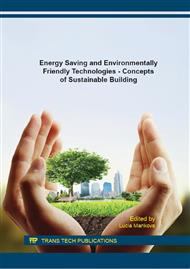[1]
Reflective Insulation, ManufacturersAssociation International (RIMA-I). Reflective Insulation, Radiant Barriers And Radiation Control Coatings. Olathe, (2002).
Google Scholar
[2]
Information on http: /web. ornl. gov/sci/ees/etsd/btric/RadiantBarrier.
Google Scholar
[3]
ASTM C1371. Standard Test Method for Determination of Emittance of Materials Near Room Temperature Using Portable Emissometers.
DOI: 10.1520/c1371-04a
Google Scholar
[4]
W. P. Goss, R. G. Miller, Literature Review of Measurement and predictions of Reflective Building Insulation Performance: 1900 - 1989, ASHRAE Transactions 1995. (1989) 651-664.
Google Scholar
[5]
G. D. Nash, J. Comrie, H. F. Broughton, The thermal insulations of buildings: Design Data and How to use Them, Her majesty's Stationery Office, London, (1955).
Google Scholar
[6]
J. M. Fricker, D. Yarbrough, Review of reflective insulation estimation methods, Conference-Building Simulation 2011. (Nov 14-16, 2011) 1989-(1996).
Google Scholar
[7]
H. E. Robinson, F. J. Powell, The Thermal Insulating Value of Airspaces, Housing Research Paper No. 32, National Bureau of Standards Project ME-12, U.S. Government Printing Office, Washington, DC. (1954).
Google Scholar
[8]
H. E. Robinson, L. Cosgrove, F. J. Powell, The Thermal Resistance of Airspaces and Fibrous Insulations Bounded by Reflective Airspaces, Building Materials and Structures Report 151, U.S. National Bureau of Standards. (1957).
DOI: 10.6028/nbs.bms.151
Google Scholar
[9]
ASHRAE Handbook of Foundamentals. Design Heat Transmission Coefficients. The American Society of Heating, Refrigerating, and Air-Conditioning Engineers is now located in Atlanta, Georgia, USA. (1972).
Google Scholar
[10]
AIRAH Handbook. Australian Institute of Refrigeration, Air-conditioning and Heating. (2007).
Google Scholar
[11]
D. W. Yarbrough, Assessment of Reflective Insulations for Residential and Commercial Applications, ORNL/TM-8891, Oak Ridge National Laboratory, Oak Ridge, TN USA. (1983).
DOI: 10.2172/940219
Google Scholar
[12]
D. W. Yarbrough, Reflective materials and radiant barriers for insulation in buildings", Materials for energy efficiency and thermal comfort in buildings, Chapter 12, Edited by Matthew R. Hall, Woodhead Publishing Limited, Cambridge, UK. (2010).
DOI: 10.1533/9781845699277.2.305
Google Scholar
[13]
B. J. Han, D. W. Yarbrough, S.M. Han, Thermal Resistance of Wall Cavities Containing Reflective Insulation" J. of Solar Energy Engineering 108. (1986) 338-341.
DOI: 10.1115/1.3268116
Google Scholar
[14]
L. R. Glicksman, Two-Dimensional Heat Transfer Effects on Vacuum and Reflective Insulations, J. of Thermal Insulation 14. (1991) 281-294.
DOI: 10.1177/109719639101400404
Google Scholar
[15]
A. O. Desjarlais, D. W. Yarbrough, Prediction of the Thermal Performance of Single and MultiAirspace Reflective Insulation Materials, Insulation Materials: Testing and Applications, American Society for Testing and Materials. (1991) 24-42.
DOI: 10.1520/stp16338s
Google Scholar
[16]
EN 6946. Building components and building elements - Thermal resistance and thermal transmittance - Calculation method.
DOI: 10.3403/00942964
Google Scholar
[17]
Information on http: /ottp. fme. vutbr. cz/users/pavelek/optika.
Google Scholar
[18]
EN 16012. Thermal insulation for buildings - Reflective insulation products - Determination of the declared thermal performance.
DOI: 10.3403/30206131
Google Scholar
[19]
EN 15976. Flexible sheets for waterproofing. Determination of emissivity.
Google Scholar
[20]
ČSN 72 7010. Determination of thermal conductivity coefficient for materials in stabilized thermal state. Common provisions. (Stanovení součinitele tepelné vodivosti materiálů v ustáleném tepelném stavu. Společná ustanovení).
Google Scholar
[21]
J. Kalánek, L. Šteffek, M. Ostrý, Emisivita a její vliv na stanovení deklarovaných tepelných vlastností reflexních izolací laboratorním měřením - metodou teplé skříně (Emissivity and its influence on the determination of thermal resistance of reflective insulation by laboratory measurement - hot box method), Juniorstav 2015 VUT Brno. (2015).
DOI: 10.4028/www.scientific.net/amr.1041.150
Google Scholar


